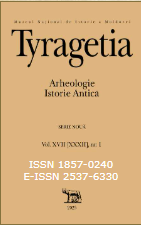Погребения позднего бронзового века из Kурганов в верхнем течении р. Красная на нижнем Днестре (по результатам исследований 2013-2022 гг.)
Graves of the Late Bronze Age from barrows in the upper course of the Krasnaya River in the Lower Dniester Region (according to the results of research in 2013-2022)
Author(s): Sergey D. Lysenko, Sergey N. Razumov, Svetlana S. Lysenko, Nicolai P. TelnovSubject(s): Archaeology, Cultural Anthropology / Ethnology, Prehistory
Published by: Muzeul Naţional de Istorie a Moldovei
Keywords: North-West Black Sea region; Dniester Region; Late Bronze Age; barrows; graves; pottery;
Summary/Abstract: The paper deals with the materials of the Late Bronze Age, found in the barrows of the “Dot”, “Sad” and “Vodovod” groups near the Glinoe village, Slobodzeya district, located in the basin of the Krasnaya River on the left bank of the Lower Dniester. 32 graves of the Late Bronze Age were recorded in 9 mounds of these groups. The materials presented in the article expand the understanding of the nature of the funeral rite and the cultural relationships of the population of the left bank of the Lower Dniester in the Late Bronze Age. Almost all burials were dated using the radiocarbon method; a total of 34 radiocarbon dates have been obtained, many of which are published for the first time. The combination of features of the funerary rite of the Late Bronze Age of the Glinoe cemetery is extremely diverse. There are at least two factors behind this diversity – the multi-vector cultural interrelations of the population on the left bank of the Lower Dniester in the Late Bronze Age and the belonging of the burials to different chronological horizons. Most of these graves can be divided into two large groups. In the first group we included burials that, on the basis of clear chronological indicators, can be attributed to the Dnieper-Prut Babino culture (20th-17th centuries BC). Of course, it includes all graves in undercuts, burials with characteristic vessels of a tripartite and jar profile, as well as with a bone buckle. We can also include in the same group burials containing artifacts associated with the EpiCorded Ware cultures of the Middle and Upper Dniester (Glinoe/Sad 1/2, 1/13). The second group includes burials that do not contain precise chronological indicators, which can be dated only within a wide range – the early and developed stage of the Late Bronze Age. It cannot be ruled out that some of them also belong to the cultural circle of Babino (which is also confirmed by radiocarbon dates), but some, most likely, occupy a later chronological position and can be attributed to the Sabatinovka horizon (16th-13th centuries BC). The ruined main burial in barrow 16 of the “Vodovod” group and the accompanying skull burial at the bottom of the ring ditch stand apart and, according to radiocarbon dates, should be attributed to the Belozerka time (12th-10th centuries BC).
Journal: Tyragetia (Serie Nouă)
- Issue Year: XVII/2023
- Issue No: 1
- Page Range: 161-193
- Page Count: 33
- Language: Russian

